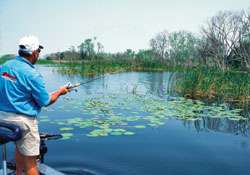
Bright green lily pads with stark white flowers make for memorable backgrounds in artists' renderings of leaping largemouth.
But consistently catching oversized bass from pads isn't easy, nor is it particularly common.
In truth, sprawling lily pad fields can be some of the most difficult and frustrating areas bassers can work. Fish can be widely scattered and difficult to locate in pads. And hauling a big bass out of the tough pad stems is a major challenge.
"I don't get excited about every lily pad bed I see, especially on sprawling lakes with hundreds of acres of pads like Santee Cooper," says Elite angler Ish Monroe of California. "But lily pads can be loaded with bass in certain areas, and at the right times of the year.
"In lakes where there is a wide variety of vegetation, such as hydrilla, milfoil or peppergrass, bass usually prefer those weeds to lily pads. But in lakes where lily pads are the dominant cover, they're very important, and are great places to catch plenty of fish. Florida's Lake Tohopekaliga and the Harris Chain of Lakes are prime examples."
Veteran tourney angler and television fishing show host Joe Thomas notes that some waters offer better pad fishing than others. The Ohio angler has many favorite pad lakes in the North, such as the St. Lawrence River, where back bays full of lily pads can be superb for largemouth (although they rarely hold smallmouth).
"To find the best pads you have to be aware of little things that attract bass to specific spots," explains Thomas. "And when you find those spots with bass, they can hold fish year after year."
One key to locating bass in lily fields is to pinpoint things that are different, like small areas intermixed with brush, logs, stumps or other types of vegetation. A submerged ditch might be too deep for lilies to grow, resulting in a cut or channel through pads that bass hold tight to. Windward pad points or gaps where wind and current cause bass forage to collect also can be choice spots, he says.
Pad fields early in the year can be prime spawning spots for largemouth, and both Monroe and Thomas have made big catches from such places. Timing is important to locating spawning fish in pad fields. In the North, this occurs when only pad stems are visible, long before oversized pads open up.
"Summer fishing can be good in pads, too, especially where giant lilies are found," contends Monroe. "The thickest beds of big pads, in the deepest water, on the hardest bottom, are best for bass. They can be excellent during midday, when the sun beats down, because it's cool and shady under the lilies, and usually there are plenty of minnows and bait under pads."
Monroe likes pads growing in 4 to 6 feet of water, and he works these stretches quickly, positioning his boat on the outside edge, casting to the bank and fishing back toward the thickest clusters in the middle of the field.
Thomas prefers small beds because they're easier to approach, and bass seem more concentrated in key areas. He casts parallel to the edges, where bass often position for feeding. If that doesn't pay off, he moves into the pads, making long casts with his frog.
Both anglers like Snag Proof's weedless Tournament Frog for initially checking pads, and they work it fast until bass are found.
"I use a white Pro Series Tournament Frog 95 percent of the time," says Monroe. "I 'walk the dog' with it, sort of like fishing a Zara Spook. I'll work it over holes in a pad field, and make it wiggle and hop in an almost stationary position, and that really triggers bass."
Thomas makes long casts with a frog, and he prefers dark lures in bright weather, and white or chartreuse under overcast skies or early and late in the day.
"I want my frog to plop down hard on pads to get the bass' attention," he states. "Then I retrieve it slowly and steadily with my rod held at a 2 o'clock position. Sometimes I'll halt the lure when it crosses a pad hole, and maybe shake the frog a bit. But most times I keep a steady rhythmic cadence to my lure retrieve, which allows bass under pads to track the lure and chase it down easily.
When a bass strikes, I drop my rod tip and allow the fish to turn its head and take up slack line. Then I point the rod at the lure, and when the line tightens, I make a sharp, snappy hook set."
Consistently hooking bass with the oversized hooks of weedless frogs — especially on long casts — isn't easy. For that reason, the two pros use heavy flippin' sticks and 50- to 60-pound-test braided line, which doesn't stretch and helps drive barbs deep.
Once they locate bass among the pads, the anglers slow the pace and flip jigs and soft plastics to key areas where fish have been located.
"Some lakes have great pad fishing, others don't; so you've got to do your homework on a body of water before spending time in pads," explains Monroe. "The whole secret to pad fishing is finding fields that have fish, then working choice spots in those lilies where bass are feeding."




